A Hybrid P&O and PV Characteristics Simulation Method for GMPPT in PV Systems Under Partial Shading Conditions
Abstract
1. Introduction
- Quickly determine the position of the LMPPs on the I-V curve based on a D value and the parameters of the photovoltaic panel.
- Proposed partial shading detection solution by adjusting the resistor step and the linear region on the I-V curve to narrow the MPP search range quickly.
- Skip the search at LMPP to accelerate convergence and improve GMPPT efficiency with small step sizes around the steady-state operating point.
2. Materials and Methods
2.1. DC/DC Converter
2.2. Impact of Environment on PV Characteristics
2.3. The Relationships at MPP of a PV Panel
- 1.
- Determine the parameter by a value of D in the voltage region less than 0.4 under actual operating conditions. Reference [17] has shown that measuring the value of in this voltage region is possible when choosing a D > 0.8. Measure and store the values , , , and at this D.
- 2.
- Calculate the value of according to using (4).
- 3.
- Estimate the value of according to (6).
- 4.
- Estimate the value of according to (13).
- 5.
- Calculate the value of using (12).
2.4. GMPP of the PV System Under PSCs
2.4.1. Determine the MPP of the PV Module with the Most Significant Radiation
2.4.2. Determine the Rest of the MPPs in the PV System
2.5. Proposed GMPPT Method
- 1.
- Step 1. Set the values D = 0.8 and the step size = 0.015 to measure of the system, which consists of N panels in the PV system. Select the value is the short-circuit current of the first region on the I-V curve. Measure and store values at D, including , , , and .
- 2.
- Step 2. Calculate of a first region based on (4).
- 3.
- 4.
- Step 4. Determine the working resistance at the MPP points (i = 2 to N) according to (17).
- 5.
- Step 5. Calculate values according to (18).
- 6.
- Step 6. Measure and store the parameters and corresponding to the value.
- 7.
- Step 7. Check the working position in shaded areas.If , then , so the controller must increase the value according to (19) and return to step 5. Otherwise, go to the next step.
- 8.
- Step 8. Calculate and store values according to to find the maximum power and corresponding D value.
- 9.
- Step 9. Select the reference power, , corresponding to the largest value of the previous step. At the same time, select the values , and corresponding to as reference values for the next steps.
- 10.
- Step 10. Check the convergence condition.Modify the parameter to monitor the resulting power and voltage outputs and then compare them with their corresponding values in the previous step to determine the optimal MPP. The algorithm reaches convergence by satisfying the constraint outlined in (25).If , reduce D to increase V; otherwise, increase D to reduce V.If the current experiences a significant deviation due to changes in operating conditions, the solution will restart the calculation from the initial MPP. Figure 5 shows the flow chart of the proposed algorithm.
3. Results and Discussion
- 1.
- Validate the ability to accurately position LMPPs on the PV system’s I-V characteristic curve under PSCs based on an initial reference position.
- 2.
- Confirming the effectiveness and simplicity of the proposed solution in improving MPPT performance and speed under PSCs.
- 3.
- Demonstrate the superior LMPP trap avoidance ability of the proposed method by simulating the I-V curve under various operating conditions.
3.1. Simulation Results
3.2. Experimental Results
4. Conclusions
Author Contributions
Funding
Institutional Review Board Statement
Informed Consent Statement
Data Availability Statement
Conflicts of Interest
References
- Kumar, M.; Panda, K.; Rosas-Caro, J.; Valderrabano-Gonzalez, A.; Panda, G. Comprehensive review of conventional and emerging maximum power point tracking algorithms for uniformly and partially shaded solar photovoltaic systems. IEEE Access 2023, 11, 31778–31812. [Google Scholar] [CrossRef]
- Katche, M.; Makokha, A.; Zachary, S.; Adaramola, M. A Comprehensive Review of Maximum Power Point Tracking (MPPT) Techniques Used in Solar PV Systems. Energies 2023, 16, 2026. [Google Scholar] [CrossRef]
- Bollipo, R.; Mikkili, S.; Bonthagorla, P. Critical Review on PV MPPT Techniques: Classical, Intelligent and Optimisation. IET Renew. Power Gener. 2020, 14, 1433–1452. [Google Scholar] [CrossRef]
- Bollipo, R.; Mikkili, S.; Bonthagorla, P. Hybrid, Optimal, Intelligent and Classical PV MPPT Techniques: A Review. Csee J. Power Energy Syst. 2021, 7, 9–33. [Google Scholar]
- Hassan, A.; Bass, O.; Masoum, M. An improved genetic algorithm based fractional open circuit voltage mppt for solar pv systems. Energy Rep. 2023, 9, 1535–1548. [Google Scholar] [CrossRef]
- Ibrahim, M.; Ang, S.; Dani, M.; Rahman, M.; Petra, R.; Sulthan, S. Optimizing step-size of perturb & observe and incremental conductance mppt techniques using pso for grid-tied pv system. IEEE Access 2023, 11, 13079–13090. [Google Scholar]
- Gong, L.; Hou, G.; Huang, C. A two-stage mppt controller for pv system based on the improved artificial bee colony and simultaneous heat transfer search algorithm. Isa Trans. 2023, 132, 428–443. [Google Scholar] [CrossRef]
- Xia, K.; Li, Y.; Zhu, B. Improved Photovoltaic MPPT Algorithm Based on Ant Colony Optimization and Fuzzy Logic Under Conditions of Partial Shading. IEEE Access 2024, 12, 44817–44825. [Google Scholar] [CrossRef]
- Gundogdu, H.; Demirci, A.; Tercan, S.; Cali, U. A novel improved grey wolf algorithm based global maximum power point tracker method considering partial shading. IEEE Access 2024, 12, 6148–6159. [Google Scholar] [CrossRef]
- Baatiah, A.; Eltamaly, A.; Alotaibi, M. Improving photovoltaic mppt performance through pso dynamic swarm size reduction. Energies 2023, 16, 6433. [Google Scholar] [CrossRef]
- Kong, L.; Wang, B.; Fan, D.; Shi, S. Optimize photovoltaic MPPT with improved snake algorithm. Energy Rep. 2024, 11, 5033–5045. [Google Scholar] [CrossRef]
- Shams, S.; Mekhilef, K.; Tey, S. Improved social ski driver-based mppt for partial shading conditions hybridized with constant voltage method for fast response to load variations. IEEE Trans. Sustain. Energy 2021, 12, 2255–2267. [Google Scholar] [CrossRef]
- Khodair, D.; Motahhir, S.; Mostafa, H.; Shaker, A.; Munim, H.; Abouelatta, M.; Saeed, A. Modeling and simulation of modified mppt techniques under varying operating climatic conditions. Energy 2023, 16, 549. [Google Scholar] [CrossRef]
- Basha, C.; Palati, M.; Dhanamjayulu, C.; Muyeen, S.; Venkatareddy, P. A novel on design and implementation of hybrid MPPT controllers for solar PV systems under various partial shading conditions. Sci. Rep. 2024, 14, 1609. [Google Scholar]
- Nahin, N.; Biswas, S.; Mondal, S.; Islam, M.; Muyeen, S. A modified PWM strategy with an improved ANN based MPPT algorithm for solar PV fed NPC inverter driven induction motor drives. IEEE Access 2023, 11, 70960–70976. [Google Scholar] [CrossRef]
- Dagal, I.; Akın, B.; Dari, Y. A modified multi-stepped constant current based on gray wolf algorithm for photovoltaics applications. Electr. Eng. 2024, 106, 3853–3867. [Google Scholar] [CrossRef]
- Jabbar, R.; Mekhilef, S.; Mubin, M.; Mohammed, K. A modified perturb and observe MPPT for a fast and accurate tracking of MPP under varying weather conditions. IEEE Access 2023, 11, 76166–76176. [Google Scholar] [CrossRef]
- Celik, A.; Acikgoz, N. Modelling and experimental verification of the operating current of mono-crystalline photovoltaic modules using four- and five-parameter models. Appl. Energy 2007, 84, 1–15. [Google Scholar] [CrossRef]
- Sakthivel, K.; Krishnasamy, R.; Balasubramanian, K.; Vijayakumar, V.; Ganesan, M. Averaged state space modeling and the applicability of the series Compensated or converter for harvesting solar Photo Voltaic energy. Sustain. Energy Technol. Assess. 2022, 53, 102611. [Google Scholar]
- Hien, B.V.; Anh, T.V.; Linh, N.T.; Khanh, P.Q. Rapidly Determine the Maximum Power Point in the Parallel Configuration of the Photovoltaic System. Sensors 2023, 23, 7503. [Google Scholar] [CrossRef]
- Hien, B.; Anh, T.; Lan, N.; Long, D. Estimating the potential maximum power point based on the calculation of short-circuit current and open-circuit voltage. IET Power Electron. 2024, 17, 402–421. [Google Scholar]
- Tey, K.S.; Mekhilef, S. Modified incremental conductance algorithm for photovoltaic system under partial shading conditions and load variation. IEEE Trans. Ind. Electron. 2014, 61, 5384–5392. [Google Scholar]
- Husain, M.A.; Jain, A.; Tariq, A.; Iqbal, A. Fast and precise global maximum power point tracking techniques for photovoltaic system. IET Renew. Power Gener. 2019, 13, 2569–2579. [Google Scholar] [CrossRef]
- Li, L.; Chen, Y.; Liu, H.; Tang, W.; Liu, M.; Wu, J.; Li, Z. A multi-producer group-search-optimization method-based maximum-power-point-tracking for uniform and partial shading condition. IEEE Access 2020, 8, 184688–184696. [Google Scholar] [CrossRef]
- Pamuk, N. Performance Analysis of Different Optimization Algorithms for MPPT Control Techniques under Complex Partial Shading Conditions in PV Systems. Energies 2023, 16, 3358. [Google Scholar] [CrossRef]


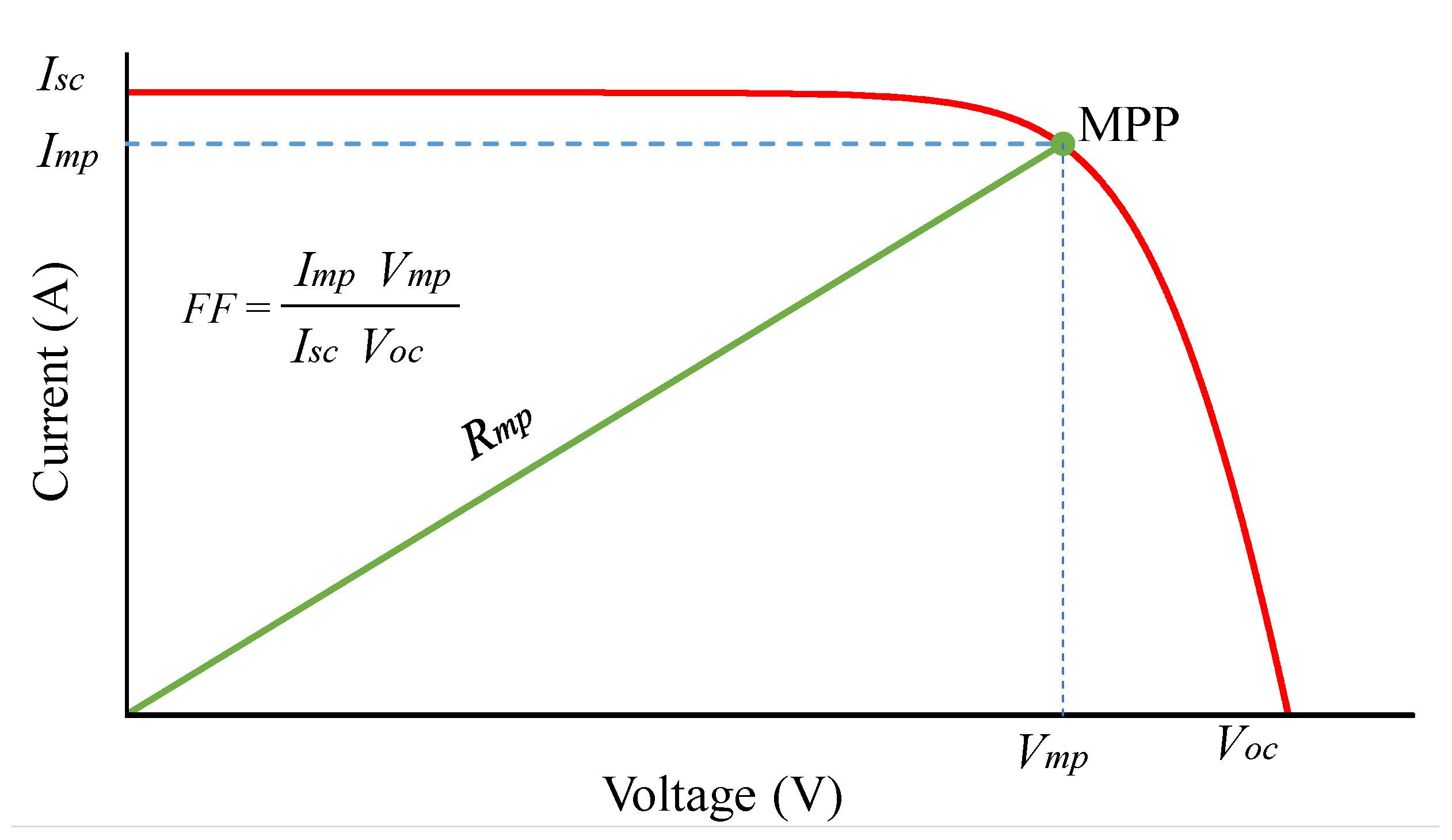
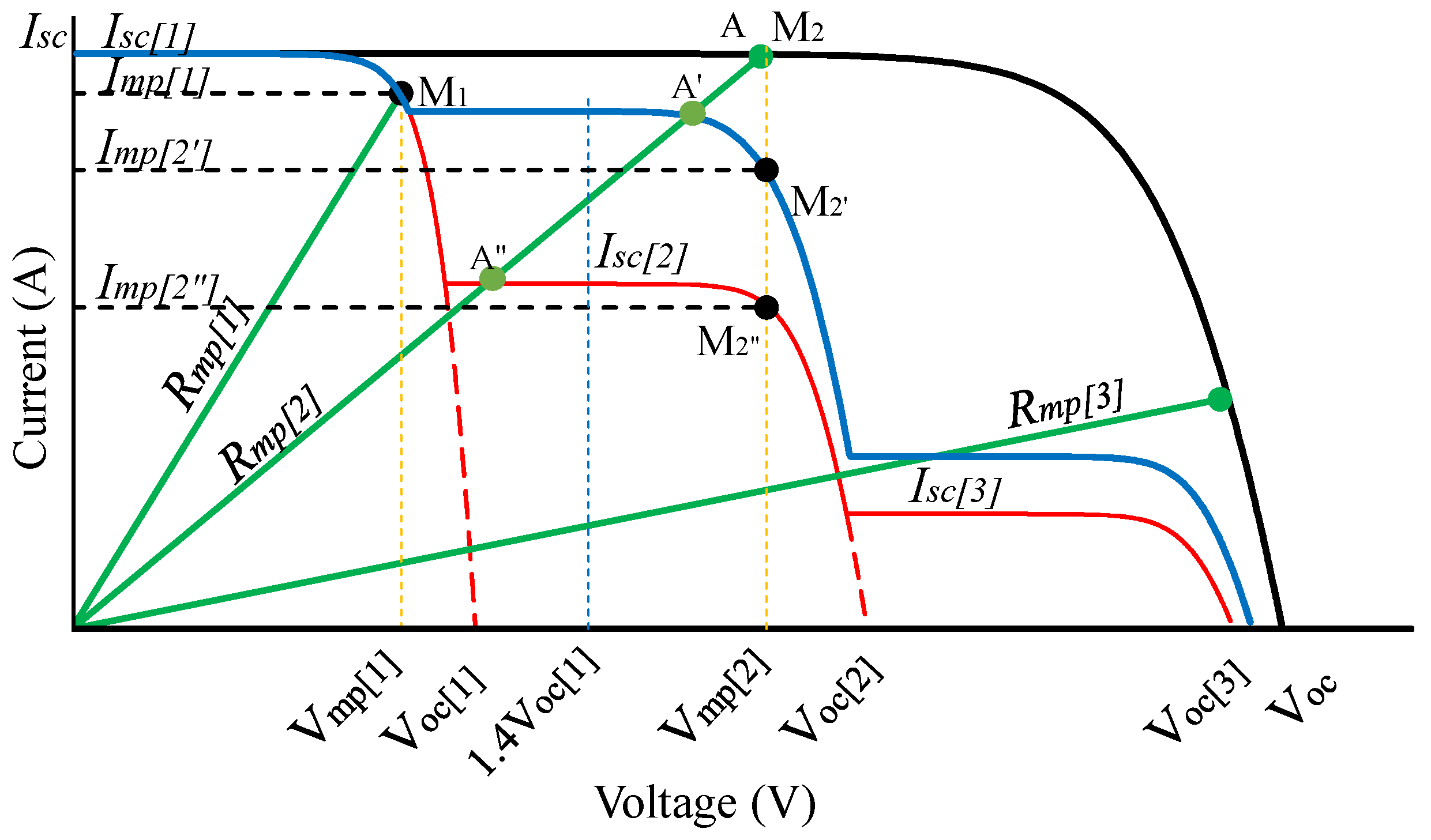
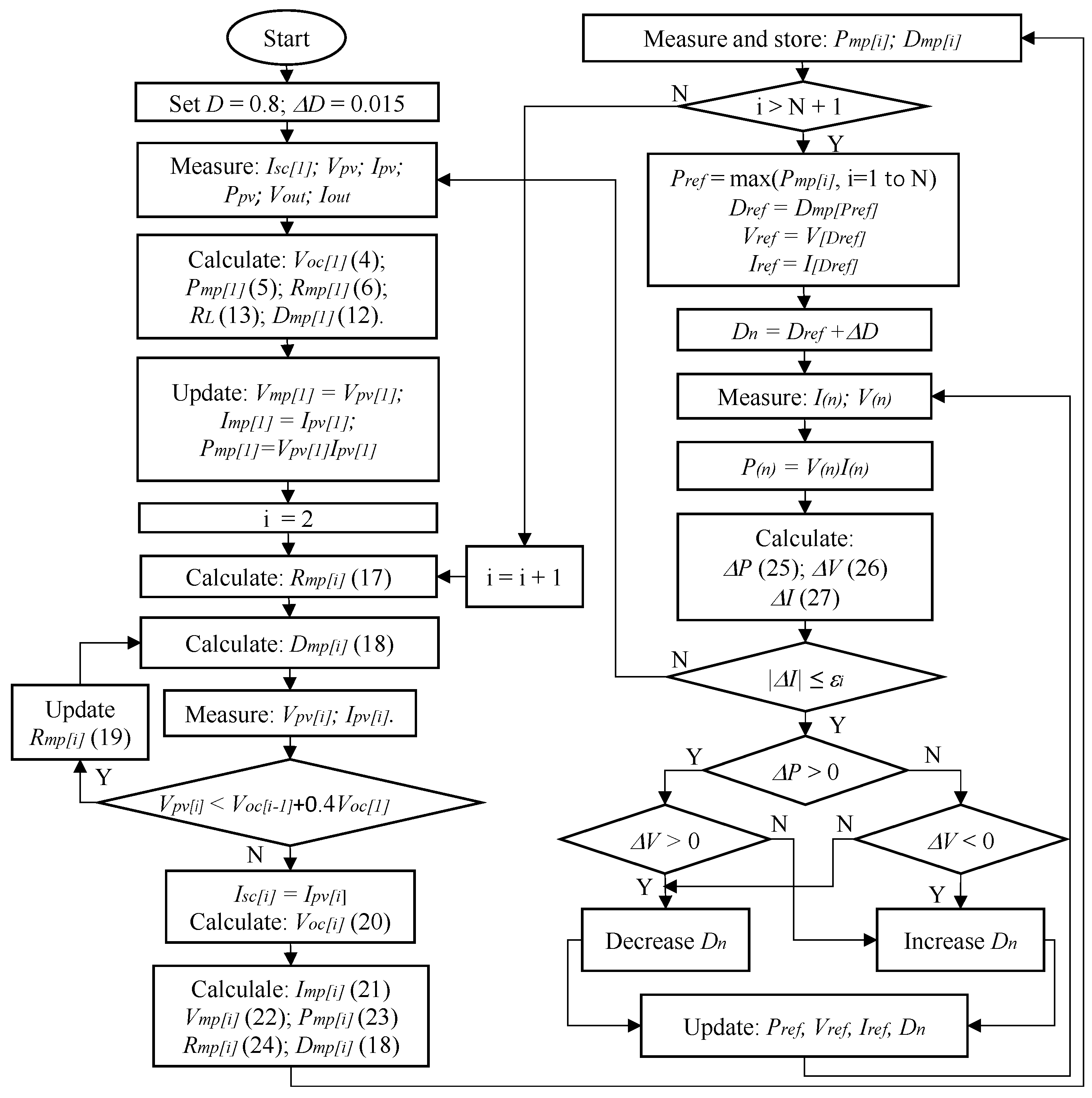

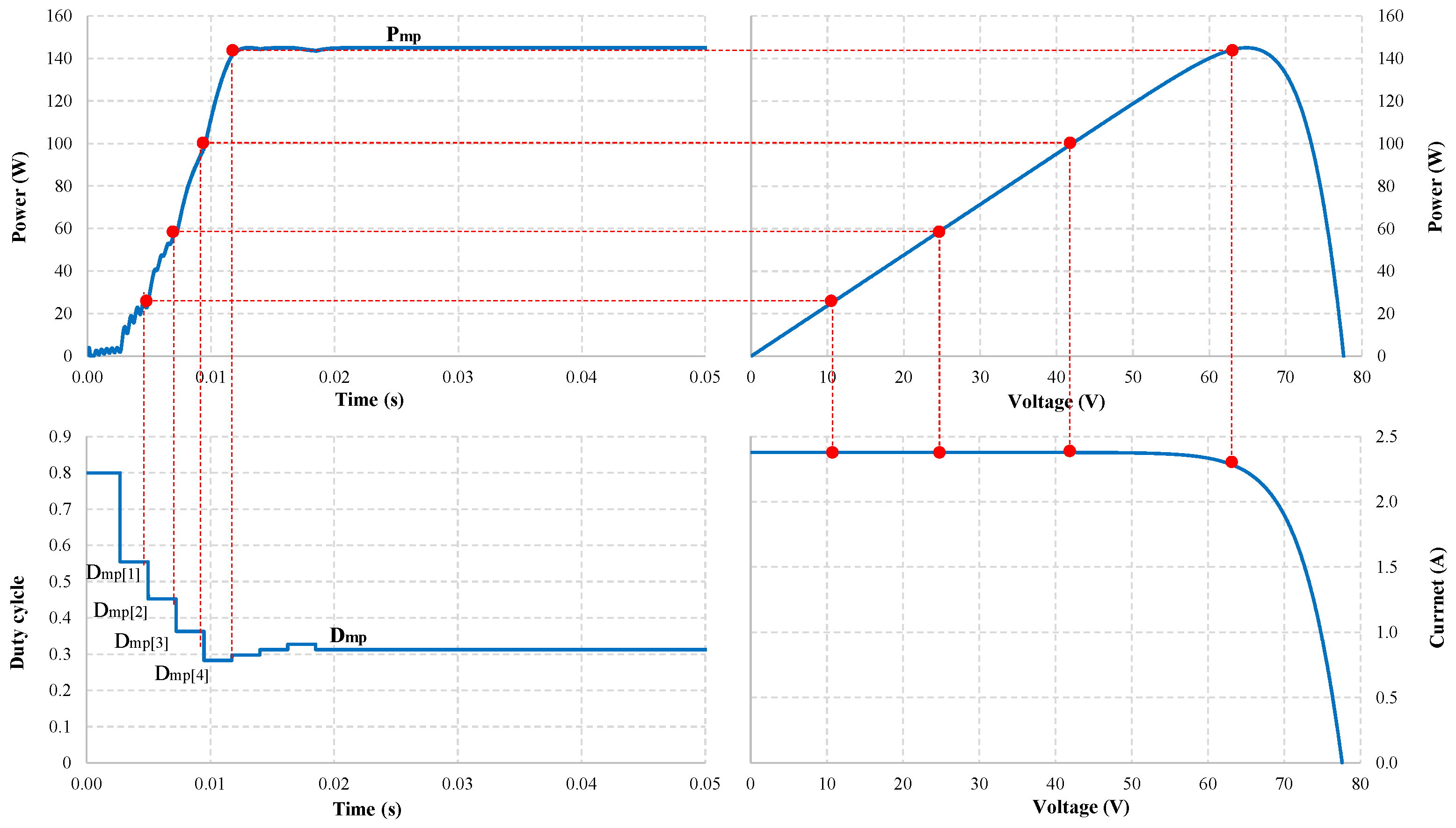
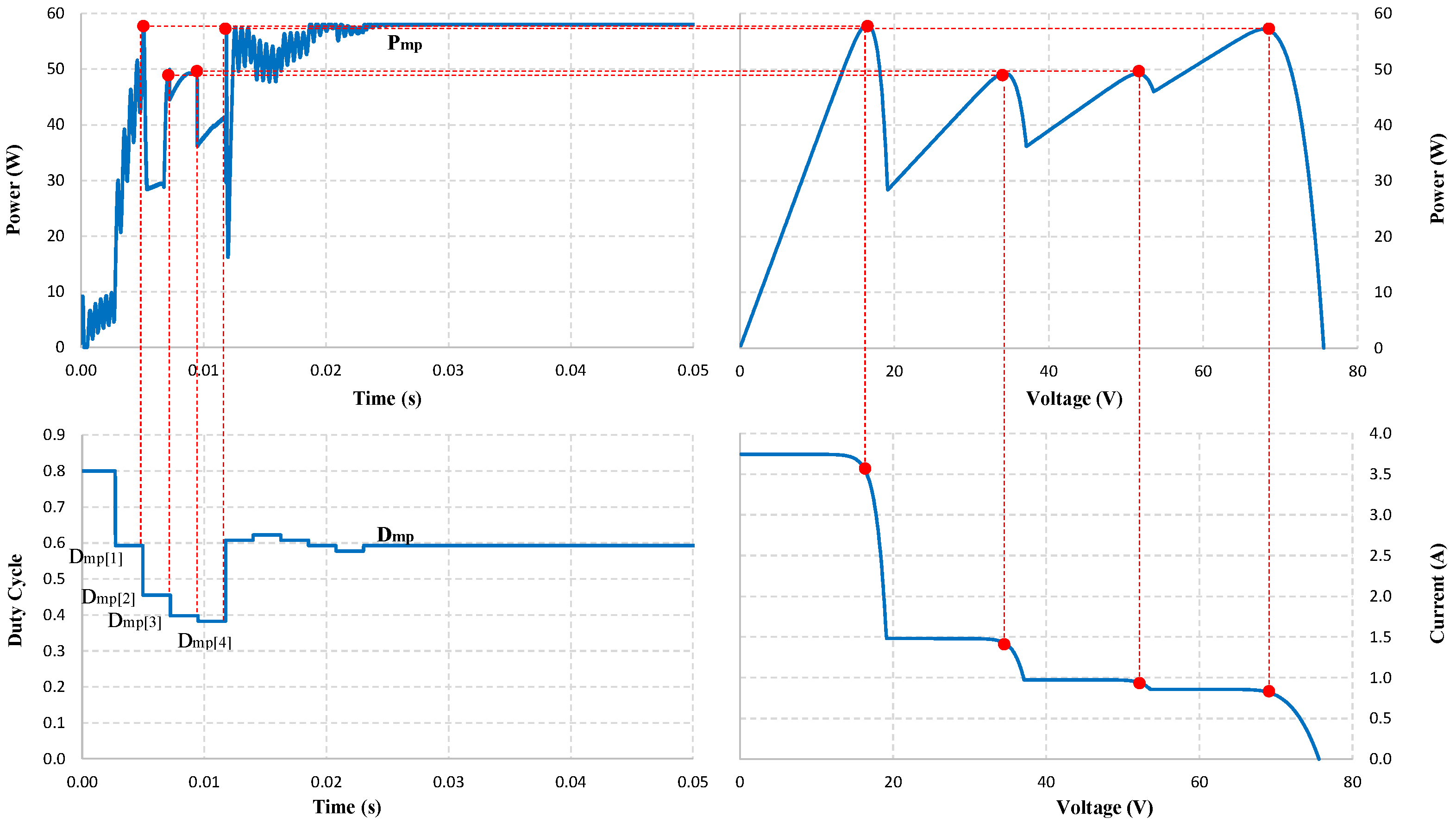
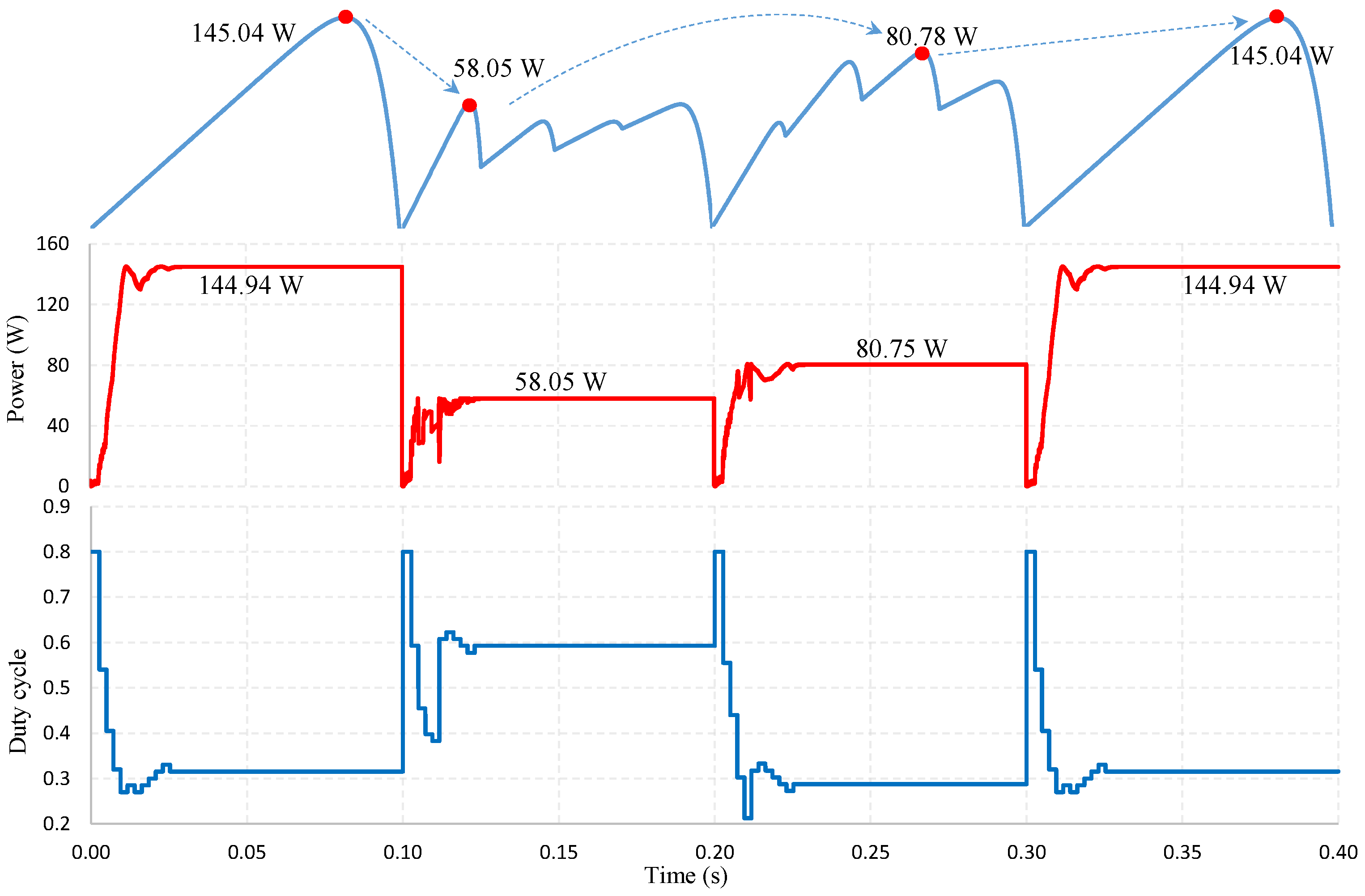
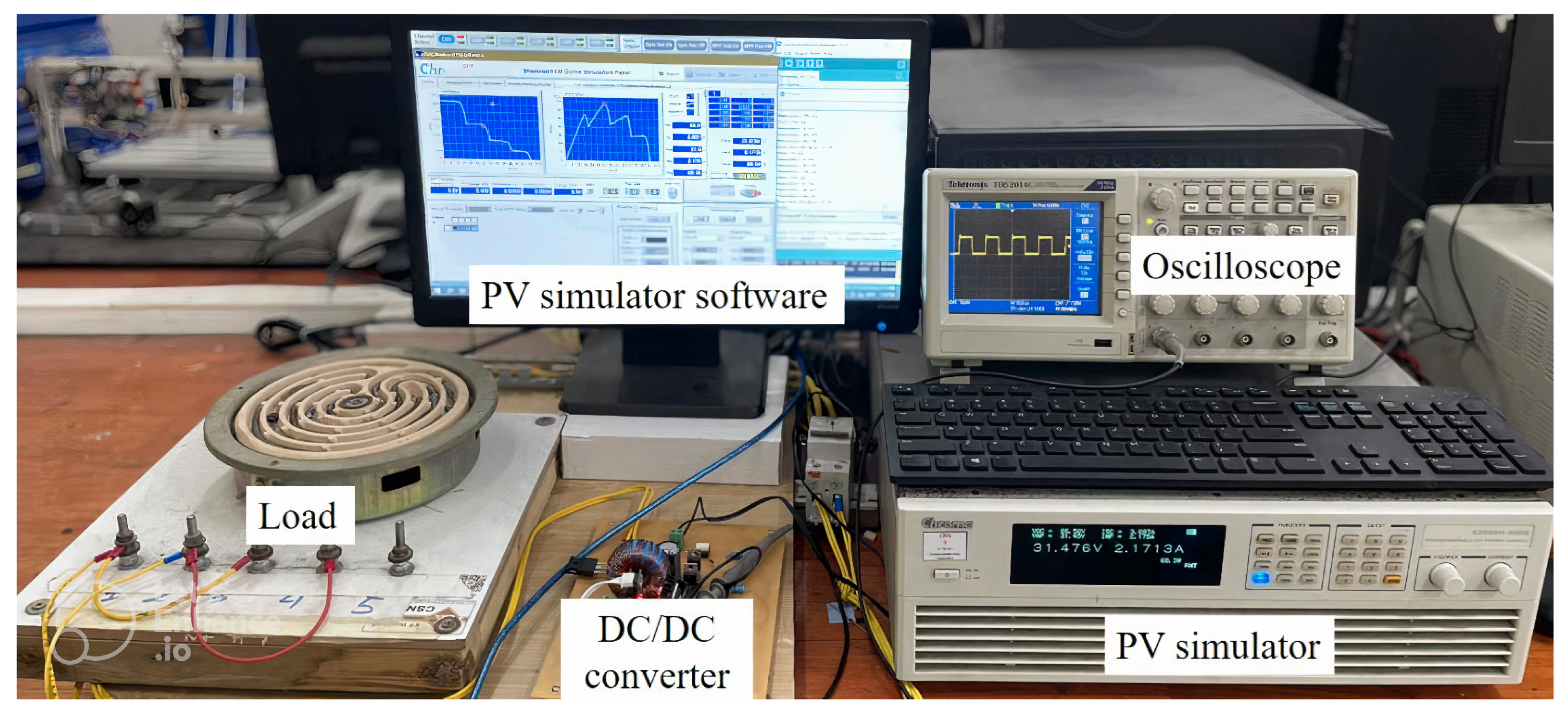

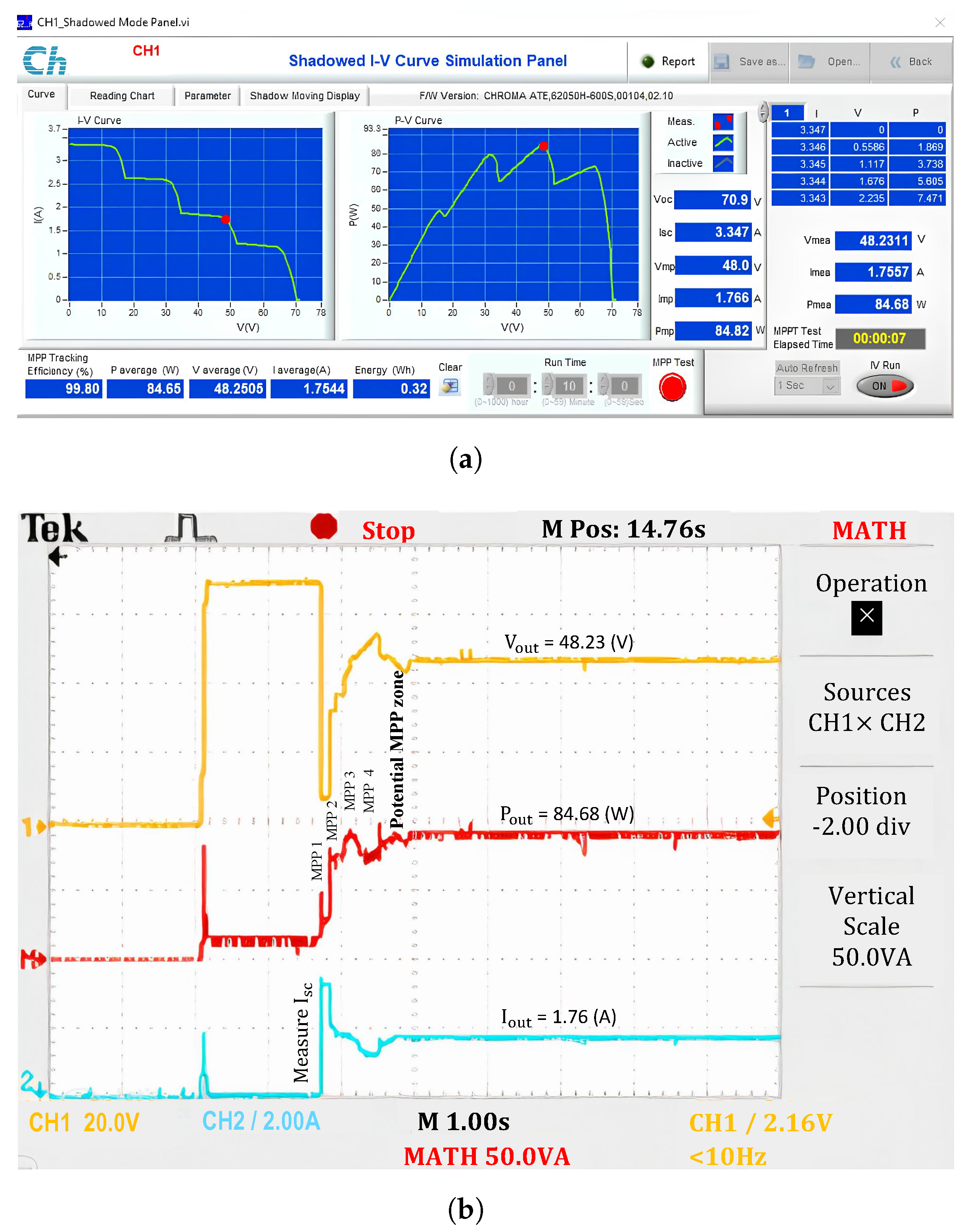
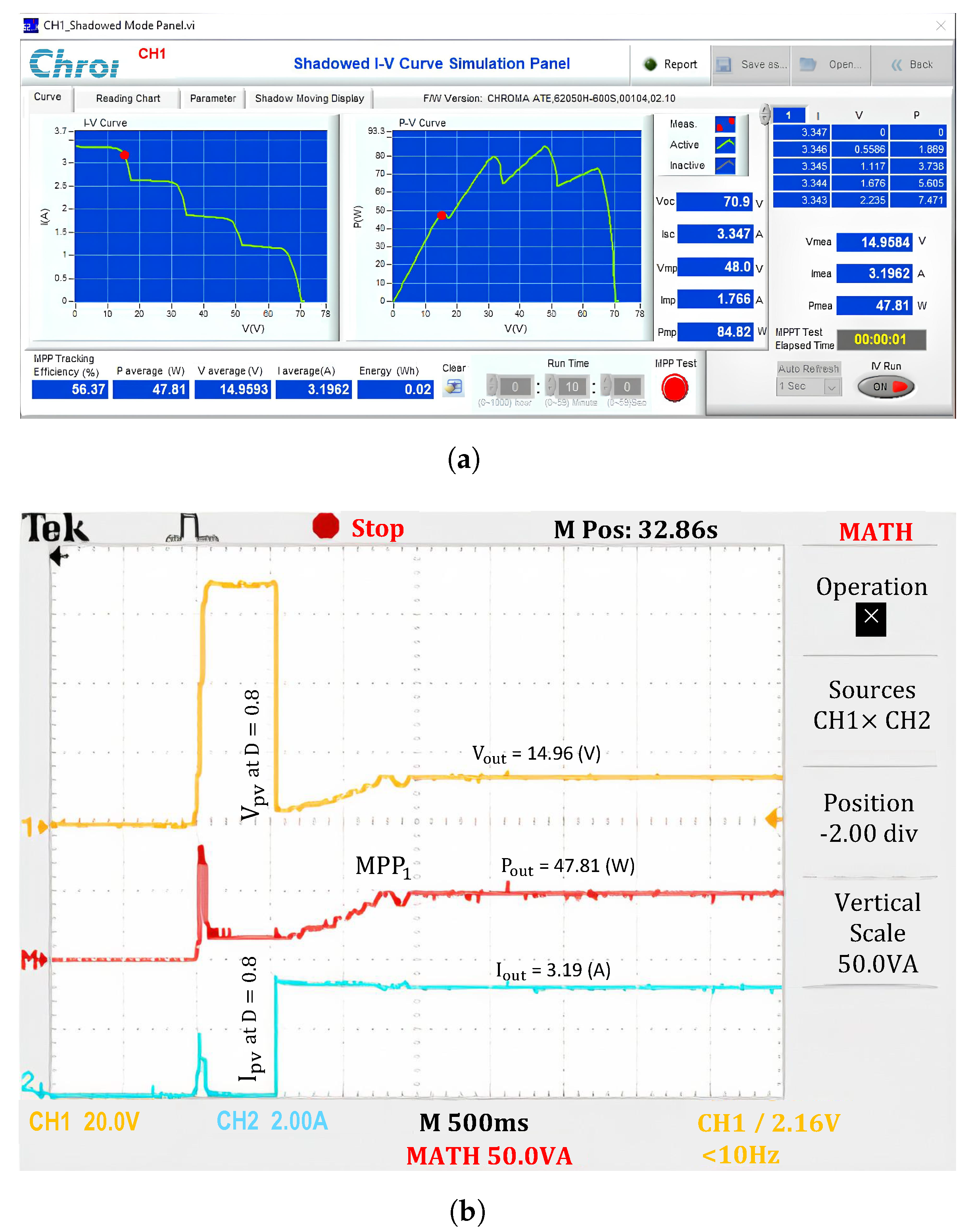
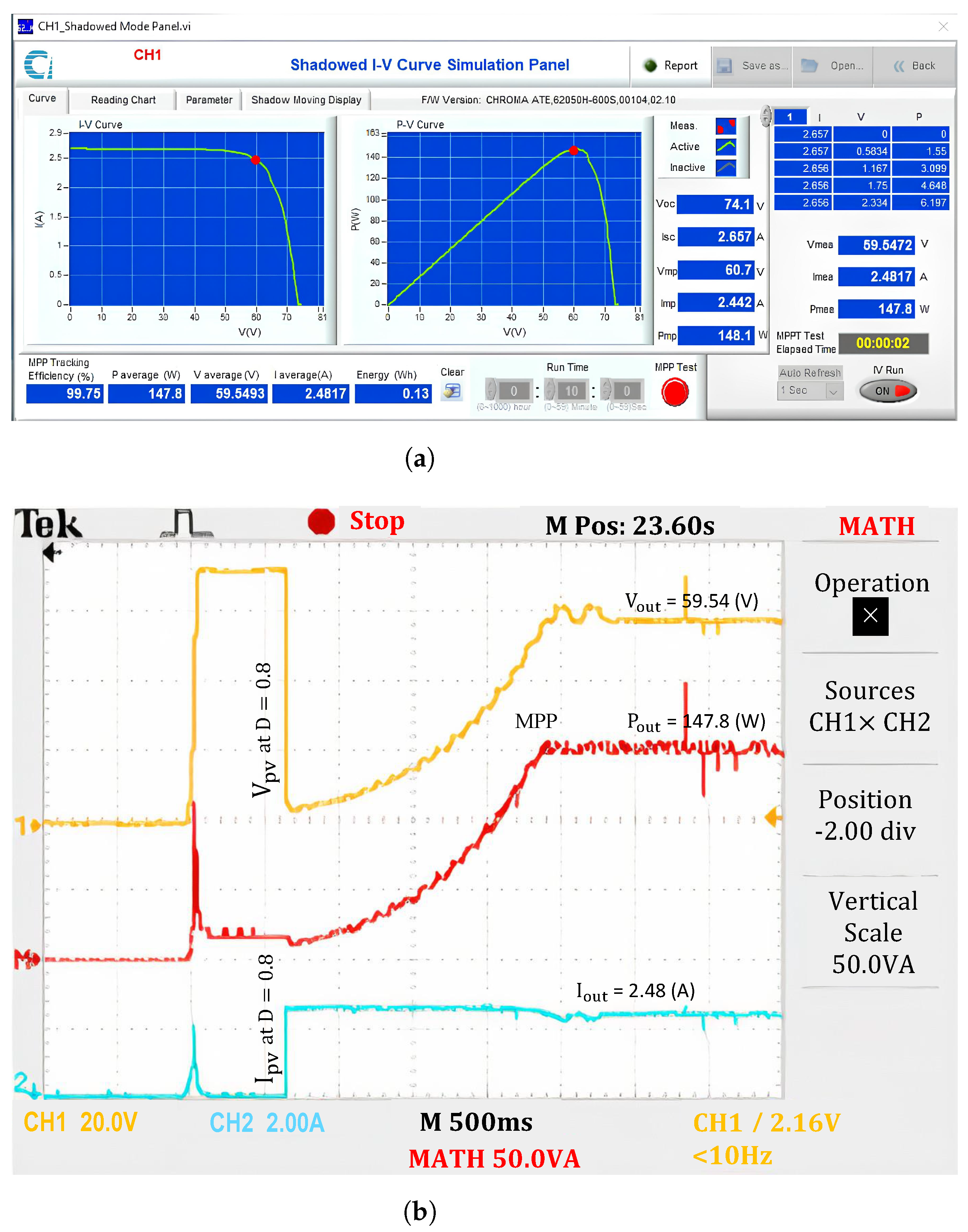
| GMPPT Method | Speed | Efficiency | PSCs | Accuracy | Complexity | Stability | Cost |
|---|---|---|---|---|---|---|---|
| ANN-P&O | VH | - | Y | H | H | H | H |
| PSO-P&O/InC | VH | 98.00 | Y | H | M | M | M |
| GWO-ANFIS [14] | H | 98.20 | Y | M | M | H | H |
| AFO [8] | M | 98.70 | Y | M | H | M | H |
| PSO | H | - | Y | M | H | H | M |
| ABC | H | 99.80 | Y | M | H | H | H |
| ACO | H | - | Y | M | H | H | M |
| ANN [15] | M | 99.81 | Y | H | H | H | H |
| BA | H | 99.90 | Y | H | H | H | H |
| GWO [9] | M | 99.57 | Y | H | H | H | M |
| GA | M | - | Y | H | H | H | H |
| P&O | L | 98.98 | N | M | L | N | M |
| InC | L | 99.94 | N | M | M | Y | M |
| CV | L | 100.00 | N | L | L | N | L |
| CC [16] | L | 99.88 | N | L | L | N | L |
| Proposed method | VH | 100.00 | Y | H | L | H | L |
| No. | (W/) | (W/) | (W/) | (W/) | GMPP Location | (W) |
|---|---|---|---|---|---|---|
| 1 | 610 | 610 | 610 | 610 | 4 | 145.04 |
| 2 | 250 | 800 | 410 | 600 | 3 | 80.78 |
| 3 | 330 | 360 | 400 | 500 | 4 | 83.25 |
| 4 | 200 | 840 | 300 | 800 | 2 | 98.17 |
| 5 | 250 | 220 | 380 | 960 | 1 | 58.05 |
| No. | | − | | (W) | (W) | MPPT Eff (%) | Time (ms) | |||
|---|---|---|---|---|---|---|---|---|
| 1 | 0.2850 | 0.3150 | 0.030 | 144.73 | 144.94 | 0.14 | 99.93 | 18.93 |
| 2 | 0.3175 | 0.2875 | 0.030 | 79.07 | 80.75 | 2.08 | 99.96 | 19.91 |
| 3 | 0.1975 | 0.2275 | 0.030 | 77.43 | 83.24 | 6.98 | 99.99 | 21.45 |
| 4 | 0.5150 | 0.4850 | 0.030 | 91.74 | 98.16 | 6.54 | 99.99 | 21.14 |
| 5 | 0.6075 | 0.5925 | 0.015 | 57.07 | 58.05 | 1.69 | 100.00 | 25.71 |
| Cases Study | 1 | 2 | 3 | 4 | 5 |
|---|---|---|---|---|---|
| Power (W) | 147.8 | 84.68 | 82.61 | 97.81 | 57.47 |
| MPPT efficiency (%) | 99.75 | 99.80 | 99.23 | 99.63 | 99.00 |
| No. | GMPPT Method | Efficiency (%) | Convergence Speed (s) | PSC Testing |
|---|---|---|---|---|
| 1 | Proposed Method | 100.00 | 0.018 | Y |
| 2 | GA - FOCV [5] | 99.96 | 0.070 | Y |
| 3 | InC - PSO [6] | 99.07 | 0.0434 | N |
| 4 | AFO [8] | 98.70 | 0.880 | Y |
| 5 | GWO [9] | 99.57 | 72 | Y |
| 6 | LS-C [11] | 99.99 | 0.080 | Y |
| 7 | CV [12] | 99.80 | 0.150 | Y |
| 8 | M-VSS-P&O [13] | 99.37 | 0.016 | N |
| 9 | CV [1] | 100.00 | - | N |
| 10 | GWO-ANFIS [14] | 98.20 | 0.020 | Y |
| 11 | CC [16] | 99.88 | 0.700 | N |
| 12 | PSO [25] | 99.96 | 0.920 | Y |
Disclaimer/Publisher’s Note: The statements, opinions and data contained in all publications are solely those of the individual author(s) and contributor(s) and not of MDPI and/or the editor(s). MDPI and/or the editor(s) disclaim responsibility for any injury to people or property resulting from any ideas, methods, instructions or products referred to in the content. |
© 2025 by the authors. Licensee MDPI, Basel, Switzerland. This article is an open access article distributed under the terms and conditions of the Creative Commons Attribution (CC BY) license (https://creativecommons.org/licenses/by/4.0/).
Share and Cite
Bui, V.H.; Ha, V.D.; Truong, V.A.; Duong, T.L. A Hybrid P&O and PV Characteristics Simulation Method for GMPPT in PV Systems Under Partial Shading Conditions. Sensors 2025, 25, 1908. https://doi.org/10.3390/s25061908
Bui VH, Ha VD, Truong VA, Duong TL. A Hybrid P&O and PV Characteristics Simulation Method for GMPPT in PV Systems Under Partial Shading Conditions. Sensors. 2025; 25(6):1908. https://doi.org/10.3390/s25061908
Chicago/Turabian StyleBui, Van Hien, Van Du Ha, Viet Anh Truong, and Thanh Long Duong. 2025. "A Hybrid P&O and PV Characteristics Simulation Method for GMPPT in PV Systems Under Partial Shading Conditions" Sensors 25, no. 6: 1908. https://doi.org/10.3390/s25061908
APA StyleBui, V. H., Ha, V. D., Truong, V. A., & Duong, T. L. (2025). A Hybrid P&O and PV Characteristics Simulation Method for GMPPT in PV Systems Under Partial Shading Conditions. Sensors, 25(6), 1908. https://doi.org/10.3390/s25061908






